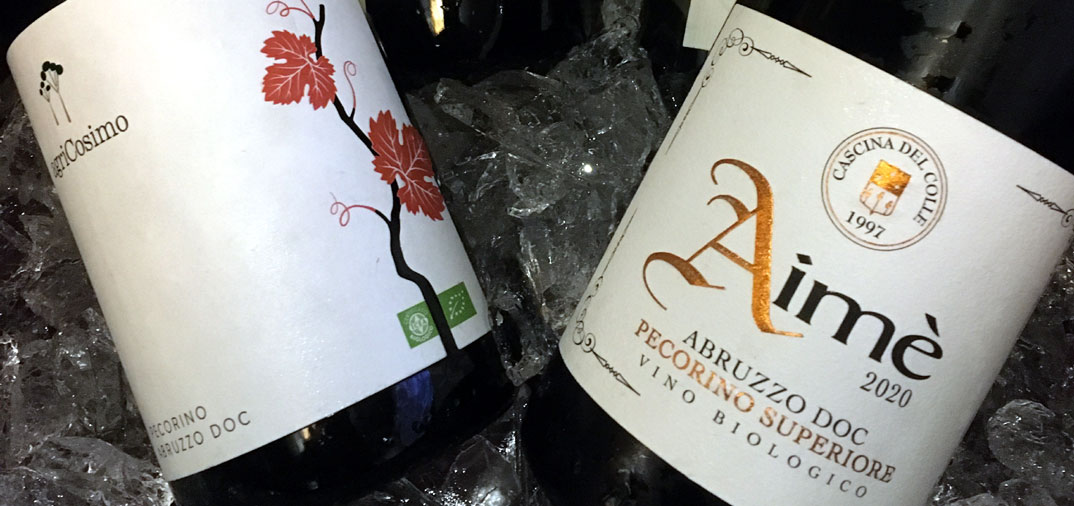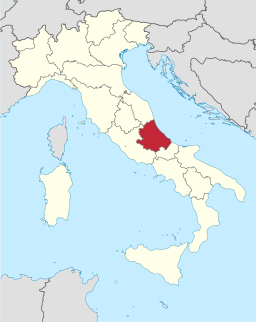
Pecorino, a Beautiful Bargain
Cheese is the first thing most people think of when they hear Pecorino, but if you’re a wine lover get ready to know Pecorino as wine. And if you like vibrant white wines at amazingly reasonable prices, this is a wine you will most definitely want to get to know.
Pecorino, the Grape
You may have not heard of Pecorino as a wine or a grape. It’s not one that I’ve come across very often, but it’s growing in prominence and availability.
Pecorino almost became a lost grape. It grew out of favor by growers during the 20th century, in part because it can be a challenging grape to grow and has low yields, leading producers to replace Pecorino vines with easier grape varieties. In the 1990’s some producers in Le Marche and Abruzzo, Italy rediscovered Pecorino and began replanting it. Today it has become one of the most notable grape varieties in Abruzzo and is also grown in other parts of Italy, like Le Marche to the north of Abruzzo.
The exact origins of Pecorino are not known, but it’s believed to be native to Italy, originating in the Sibillini Mountains, and related to Trebbiano.
Pecorino, the Name
It’s believed the transumanza, where shepherds migrate their sheep, led to the association of the Pecorino name with this grape.
Transumanza is a traditional migration in September where shepherds lead their sheep from the mountains in Abruzzo down to Puglia in the south. During this journey, the sheep would pass through the vineyards of Abruzzo. Pecorino grapes ripen earlier than other varieties, making them appealing to the sheep to eat during this journey. The rumor is that shepherds would give Pecorino cheese to vineyard owners as compensation for grapes eaten by the sheep, hence growers began to refer to these grapes as Pecorino.
Pecorino, the Wine
As a wine, Pecorino often has vibrant acidity and strong lemon characteristics, making it a great wine for pairing with oysters or other seafood. But lemon isn’t the only tropical fruit expression of the wine. Some of those I tasted also reflected pineapple, grapefruit and peach characteristics. It’s also quite aromatic, offering herbal and floral notes. Every Pecorino I’ve tried has a slight salinity to it as well.
Given the tendency for this variety to ripen early, the grapes can have high sugar content which translates to higher alcohol levels in the wine. It’s not uncommon to find these wines with 14% ABV or greater.
The best examples of Pecorino come from higher elevations, where the grapes take a little longer to ripen and there’s a stronger diurnal shift which elevates acid levels in the grapes. I haven’t tasted any Pecorino that lacked acidity, but those from higher elevations are dialed in just a touch better than others.
Pecorino is typically fermented in stainless steel and doesn’t spend any time in oak. In fact, I haven’t come across any Pecorino that wasn’t produced in stainless — although there could be some out there. Most do not go through malolactic fermentation, although some do.
Most Pecorino is very affordably priced, typically selling in the $15-20 range. Nonetheless, this isn’t just an average, everyday wine but is one with character and enough structure to give the wine good ageing potential.

The Abruzzo Region
 Although it’s produced in some other parts of Italy, all of the Pecorino I’ve tasted has come from Abruzzo. This is a relatively rural part of Italy on the Adriatic coast. Pescara, the largest city in Abruzzo, only has a population of about 123,000. It’s not a densely populated region.
Although it’s produced in some other parts of Italy, all of the Pecorino I’ve tasted has come from Abruzzo. This is a relatively rural part of Italy on the Adriatic coast. Pescara, the largest city in Abruzzo, only has a population of about 123,000. It’s not a densely populated region.
Abruzzo is both a mountainous and a coastal region, where you can drive from the mountains to the coast in about 40 minutes. Vineyards and wildlife cover much of the land, making this an absolutely beautiful region. Over 30% of the territory in Abruzzo is protected by national parks. The photo above gives you a glimpse of what this region looks like.
There are 34,000 hectares (84,000 acres) of vineyards producing 3.5 million hectolitres (92 million gallons) of wine each year in Abruzzo. That’s the equivalent of 140 Olympic swimming pools full of wine!
Abruzzo DOC
About a third of the wine produced in Abruzzo is controlled by the Abruzzo DOC, a legally protected designation with oversight from a consortium of viticulturists and winemakers. The consortium sets standards that must be met in order for a wine to be labeled with the DOC designation.
The DOC specifies the territories where grapes can be grown, the types of grapes allowed in different wines and allowed winemaking practices, to name a few things. They also require all wines be submitted to a tasting panel that evaluates whether the wine meets expectations for typicality. All of this gives consumers some assurance of what they can expect from wines under DOC labeling.
Almost 80% of the wine under the Abruzzo DOC is a red wine called Montepulciano d’Abruzzo. The most planted white grape in the region is Trebbiano. I don’t know the exact amount of Pecorino produced, but my understanding is there are only about 1,200 hectares planted — making it just a small fraction of the wine produced in this region. The quantities may be small for now, but it’s a rising star so I’m confident we’ll see that number increase.
Recommended Pecorino Wine
I have yet to come across a Pecorino I wouldn’t recommend, but here are a few I tasted recently and can confidently suggest to you.
Cascina Del Colle, Aimè, Abruzzo DOC Pecorino: A classic example of a Pecorino with herbal and lemon aromas, lemon and melon flavors, and a tart, salty finish. Organically-grown grapes. Average price: $15
Barone di Valforte, Abruzzo DOC Pecorino: Another classic Pecorino with sage and lemon aromas on the nose. The acidity is very vibrant, giving brightness to the lemony flavors. Organically-grown grapes. Average price: $17
Torre Dei Beati, Giocheremo con i Fiori, Abruzzo DOC Pecorino: The name of this wine translates to “we will play with the flowers” which is an appropriate name, given the floral aromatics from this wine. This one spent 6 months on the lees, which gives the wine a rich texture and a slight nuttiness. Again, the citrus is quite vibrant and salinity rounds out the finish. Organically-grown grapes. Average price: $14
AgriCosimo, Abruzzo DOC Pecorino: This is one of the most unique ones I tasted because it’s the only one that has gone through full malolactic fermentation. It has a rich texture as a result. This one has more tropical fruit characteristics, like pineapple, peach and grapefruit. It’s very herbal too. Certified organic.
Find and purchase other Pecorino wines at Wine.com
What Others Are Saying
Here are some links to other articles about Pecorino
- Vinepair – Everything You Need to Know About Pecorino Wine
- James Suckling – $15 Wines that Taste Like $50: Pecorino
- The Italian on Tour – A Quick Guide to Pecorino
- Forbes – Italy By The (Wine) Glass: Pecorino From Abruzzo
- Wikipedia – Pecorino (grape)










